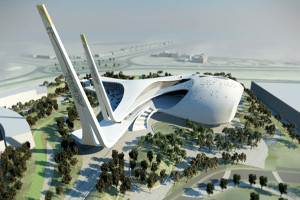GCC Hosts USD 115 Billion Worth of Rail Projects
Comfortable Stations that Absorb Sound and Provide Light Key for Growing Ridership, Say Experts in Build-Up to The Big 5
With the GCC hosting USD 115 billion worth of rail projects, comfortable stations will be key for growing ridership, industry experts announced today in the build-up to The Big 5 construction exhibition.
The GCC hosts rail, tram, light rail, metro, and monorail projects, with the Kingdom of Saudi Arabia leading at USD 45 billion, followed by Qatar at USD 35 billion, the UAE and Kuwait at USD 15 billion, and Bahrain at USD 10 billion, according to a report by the German Near and Middle East Association.
Regional metro projects include the Dubai Metro expansion, construction in Doha, Qatar, and Riyadh, Kingdom of Saudi Arabia, and plans for metros in Jeddah, Medina, and Dammam in the Kingdom.
“While the GCC countries are constructing a large number of rail projects, in order for them to succeed in growing strong ridership numbers, they need to create uncluttered, well-lit stations where travellers feel comfortable,” said Frans van de Laak, General Manager, Hunter Douglas Middle East Fze, an international ceiling manufacturer that has worked on prominent rail stations including the Dubai Metro and the Delft Railway Station in The Netherlands.
“Ceilings play an important part in enhancing the traveller experience, as they can absorb sound, lead travellers toward trains, and make travellers feel safe by providing human-sized proportions and ample lighting,” added Frans van de Laak.
In both the Dubai Metro’s Union Station, one of the busiest stations in the system, and the Delft Railway Station, Hunter Douglas installed ceilings with tapered baffles of extruded aluminium.
These ceilings have the strength to handle the trains racing by, and with half the reverberation time of traditional train stations, can absorb the noise of trains and travellers.
“This is just one small part of a complex puzzle,” said Daniël Jongtien, architect at Benthem Crouwel Architects, on the Delft Railway Station. “Together with Hunter Douglas, we designed the baffles in such a way that they bow, as it were, to the rush of passers-by, with the vertical baffles gradually turning horizontal. It provides a natural way of leading travellers towards the stairs.”
An important factor in making sure travellers in an underground station feel safe is light, which is why in between the baffles, artificial lighting has been installed. At 110 gloss units, the baffles have an exceptional gloss level for reflecting light. Special weather-resistant coatings can also reflect daylight.
Both projects brought logistical challenges, with Hunter Douglas fitting the components into place piece-by-piece, along with tight planning, and efficient installation thanks to an efficient numbering system.
About Hunter Douglas
Hunter Douglas is market leader both globally and in the Netherlands for innovative, aesthetic, high-quality window coverings, sun control systems and architectural ceiling and façade panels. For almost 50 years, Hunter Douglas products have contributed to the sustainable thermal, acoustic and visual appeal of buildings across a wide range of branches and sectors, from trade to industry and from the catering business to government.
These products consistently meet the needs of architects, designers and contractors, thanks to Hunter Douglas’ intensive collaboration with these parties. Minimising environmental impact and waste flows is a vital part of the development, production, distribution, servicing and reuse of each product.
The main office of the Hunter Douglas Group is in Rotterdam, the Netherlands. Local units on every continent include over 60 factories, 100 assembly plants and marketing offices in over 100 countries. Over 16,500 staff members around the world invest their talents and skills in Hunter Douglas.













